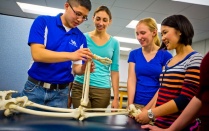our alumni
Asmita (Salang) Mudholkar

During her time in the Occupational Therapy program, Asmita (Salang) Mudholkar, MS, OTR, gained a reputation as a dedicated, disciplined student. Her dedication has paid off—she’s now a PhD candidate and associate lecturer in OT at the School of Health & Behavioural Sciences,
University of the Sunshine Coast, Australia.
What have you been doing since you left Buffalo?
I received my MS in OT degree in early 2009 and started work as an OT in one a skilled nursing facility in New Jersey. I moved to India in November 2011 to get married. Meanwhile, I started work as a part time pediatric OT in one of the private OT clinics in Mumbai, India.
How did you end up in Australia?
We always loved the prospects of moving to Australia for two main reasons. One was that we could move to Australia as permanent residents based on our skills (and not on a working visa), and the second one was the beautiful weather all year round and a better lifestyle. While I was working in New Jersey, I started my paperwork to get my skills approved by the OT Council of Australia. Fortunately, before I moved back to India, I had a positive skills assessment from the OT board of Australia. After I got married, we started our visa paperwork for permanent residency. Our permanent residency was approved in April 2012, and we moved to Australia in May 2012.
How has your career progressed in Australia?
I started work as an OT in one of the biggest private pediatric OT clinics in Brisbane, Queensland. I worked there for a year, but I always wanted to work in multidisciplinary teams covering the whole lifespan if possible. In July 2014, I was offered a senior OT position with Queensland Health (the state’s largest public health provider). There, I got to work in a multidisciplinary team alongside some brilliant clinicians. I worked in that position for six years, where along with a clinical caseload I supervised allied health assistants and OT students.
Why did you move into the research realm?
I always wanted to be a researcher since I started work on my thesis with Dr. Machiko Tomita during the OT MS program at UB. I had always been in awe of the work that Dr. Tomita was doing, and it always inspired me. But it took me a while to get started with this journey. I always wanted to know “why we do what we do” in OT, and of course, we do have a lot of brilliant clinicians in OT, but not a lot of researchers (especially here in Australia). Hence, I decided to seek PhD in OT. Fortunately, I found Dr. Alison Lane at the University of Newcastle who shared similar interests in research ideas, and I applied for my PhD with her as my supervisor in late 2019.
How did your teaching position come about?
I had started to look for a role change that would support me in my PhD journey and where I could gather experience along the way. In 2019, I applied for a position as an associate lecturer in occupational therapy at the University of the Sunshine Coast, Queensland.
To my surprise, I was offered the position after a stringent interview process. I commenced in this role in January 2020, and I started my PhD studies in March. It has been a challenging year with the new role change and the pandemic, but it did give me time to reflect on my journey as an OT since completing my MS. I am forever grateful for Dr. Tomita’s support and encouragement throughout my MS. It has definitely inspired me to be a researcher, and finally I am in the right space!
What are your research goals?
I would like to make a positive and sustainable contribution by generating high-quality research in occupational therapy. I would like to grow my own research capacity and hopefully profile the contribution of occupational therapy researchers worldwide.
